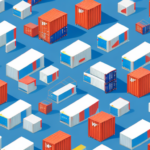Maximizing Supply Chain Efficiency with FEU (Forty-foot Equivalent Unit) Solutions
The use of FEUs in supply chain management has gained significant attention recently due to their benefits in cost reduction and supply chain optimization. In this article, we will explore what an FEU is, its impact on the shipping industry, benefits of using FEUs in supply chain management, challenges in implementing FEUs for your business, selecting the right type of container for your product, the role of digitalization in optimizing FEU supply chains, reducing costs and improving efficiency with FEUs, best practices for managing and maintaining FEUs, and trends and future developments in the use of FEUs in the shipping industry.
What is an FEU and How Does it Affect Supply Chain Efficiency?
A Forty-foot Equivalent Unit (FEU) is a standard international shipping container size equivalent to two twenty-foot Equivalent Units (TEUs). The integration of FEUs in supply chain management has enhanced productivity and minimized costs for many businesses. They have standardized and simplified container transportation globally, leading to improved supply chain efficiency. With FEU solutions, companies can transport large volumes of goods in bulk, saving time and reducing freight costs.
According to the Global Shipping Industry Report 2023, the use of FEUs has contributed to reducing carbon emissions in the transportation industry. By transporting more goods in a single container, companies can reduce the number of trips required to move the same amount of cargo, thereby decreasing the carbon footprint of their operations. This sustainability advantage has made FEUs a preferred choice for businesses prioritizing eco-friendly supply chain management.
However, the use of FEUs presents challenges. Not all ports and transportation modes can accommodate these larger containers, limiting supply chain flexibility. Additionally, the cost of purchasing or leasing FEUs can be higher than smaller containers, posing a barrier for small businesses. Despite these challenges, the benefits of using FEUs in supply chain management outweigh the drawbacks, making them likely to remain a popular choice for businesses.
The Evolution of Containers in the Shipping Industry
The evolution of containers in the shipping industry began in the 1950s with the introduction of standardized shipping containers. Initially, containers were small and could not accommodate much cargo. Over time, manufacturers developed larger and more efficient containers, such as FEUs, to handle increased freight volumes. The development of FEUs has led to significant cost savings for shippers by allowing bulk movement of goods, thereby reducing transportation costs. This advancement has had a profound impact on supply chain management.
Another significant development is the introduction of refrigerated containers, also known as reefers. These containers are designed to transport perishable goods, such as fruits, vegetables, and pharmaceuticals, at specific temperature ranges. The use of reefers has revolutionized the transportation of perishable goods, maintaining the quality and freshness of products during transit. This innovation has opened new markets for producers and increased the availability of fresh produce worldwide.
Furthermore, the evolution of containers has led to the development of specialized containers for specific types of cargo. For instance, flat rack containers are designed to transport oversized cargo like machinery and vehicles, while open-top containers accommodate goods that cannot be loaded through standard doors. The availability of specialized containers has expanded the range of goods that can be transported by sea, enhancing flexibility and efficiency in the shipping industry.
Benefits of Using FEUs in Supply Chain Management
There are numerous benefits to using FEUs in supply chain management, including:
- Reduced transportation costs: Bulk shipping lowers per-unit costs.
- Increased loading efficiency and cargo protection: Larger containers reduce handling and damage.
- Enhanced security and reduced risk: Standardized containers are easier to secure.
- Improved inventory management, storage, and distribution efficiency: Streamlined processes reduce delays.
- Streamlined shipping processes: Standardization simplifies logistics.
- Ability to transport a wide variety of goods: Versatility in cargo types.
Additionally, FEUs help businesses reduce their carbon footprint. By transporting more goods in a single trip, the number of required trips decreases, leading to lower fuel consumption and emissions. According to the Intergovernmental Panel on Climate Change (IPCC) Report 2023, optimizing container usage is a crucial strategy in reducing greenhouse gas emissions in the transportation sector.
FEUs also enhance supply chain visibility. Implementing tracking technologies allows businesses to monitor the location and status of shipments in real-time. This real-time data helps identify and resolve issues promptly, improving overall supply chain efficiency and customer satisfaction. Enhanced visibility is supported by platforms like ShipScience, which provide integrated tracking solutions for better decision-making.
Challenges in Implementing FEU Solutions for Your Business
While FEUs offer numerous benefits, businesses face several challenges when implementing FEU solutions, including:
- Upfront costs: Acquiring or leasing FEUs can be expensive.
- Risk of damage to goods: Larger containers may pose handling challenges.
- Need for adequate storage space: FEUs require more storage capacity.
- Strict regulations and compliance: Varying regional regulations can complicate logistics.
Additionally, implementing FEU solutions often requires specialized equipment and infrastructure. FEUs necessitate specific handling equipment, such as cranes and forklifts, which can be costly to obtain and maintain. Businesses might also need to invest in infrastructure modifications, like strengthening warehouse floors to support the weight of loaded FEUs.
Coordinating transportation and logistics for FEUs can be complex, especially for businesses operating in multiple regions. Navigating different transportation regulations and customs requirements demands meticulous planning and coordination. Partnering with experienced logistics providers can help mitigate these challenges and ensure smooth implementation of FEU solutions.
Choosing the Right Type of Container for Your Product
Selecting the appropriate container type is essential to ensure that your goods reach their destination safely, efficiently, and cost-effectively. Key factors to consider include:
- Weight and dimensions: Ensure the container can accommodate the size and weight of your cargo.
- Type of cargo: Different goods may require specialized containers, such as refrigerated or hazardous materials containers.
- Mode of transportation: Containers must be compatible with the transportation method, whether by sea, rail, or road.
For example, if you're shipping temperature-sensitive products, refrigerated containers are necessary to maintain the required temperature range. Similarly, transporting hazardous goods mandates the use of containers that comply with regulatory standards for safety and environmental protection.
The ShipScience Container Types Guide provides detailed information on selecting the right container for various cargo types, ensuring that businesses make informed decisions tailored to their specific needs.
The Role of Digitalization in Optimizing FEU Supply Chains
Digitalization plays a pivotal role in optimizing FEU supply chains by enhancing visibility, reducing fraud, and increasing transparency. Implementing digital technologies can automate supply chain processes, improve communication, and foster collaboration among stakeholders, thereby boosting efficiency and reducing costs.
Real-time tracking and monitoring of shipments are significant advancements enabled by digitalization. These technologies provide accurate delivery estimates and minimize the risk of lost or delayed shipments, leading to increased customer satisfaction and loyalty. Platforms like ShipScience Tracking offer comprehensive tracking solutions that integrate seamlessly with existing supply chain systems.
Moreover, digitalization supports the adoption of sustainable practices in the shipping industry. Technologies such as Blockchain and the Internet of Things (IoT) facilitate the implementation of eco-friendly initiatives, like the use of alternative fuels and the reduction of carbon emissions. According to the McKinsey Report 2023, digital transformation is essential for achieving sustainability goals and maintaining competitiveness in the evolving shipping landscape.
Reducing Costs and Improving Efficiency with FEU Solutions
Implementing FEU solutions in supply chain management offers substantial cost reductions and efficiency improvements. Key benefits include:
- Reduced transportation costs: Bulk shipping lowers per-unit costs.
- Increased loading efficiency: Larger containers reduce the number of trips required.
- Cargo protection: Standardized containers minimize handling and damage risks.
- Inventory management: Streamlined processes enhance storage and distribution efficiency.
FEUs also help businesses decrease delivery times and reduce the risk of freight-related issues such as theft or damage. The versatility of FEUs allows them to transport a wide range of cargo types, including dry goods, refrigerated items, and hazardous materials. This adaptability makes FEUs an ideal solution for businesses with diverse shipping needs.
From an environmental perspective, FEUs contribute to sustainability by optimizing transportation routes and reducing the number of required trips, thereby lowering fuel consumption and emissions. This not only benefits the environment but also helps businesses achieve their sustainability objectives and enhance their reputation among environmentally conscious consumers.
Best Practices for Managing and Maintaining FEUs
Effective management and maintenance of FEUs are crucial for ensuring their longevity and maximizing their benefits. Implementing the following best practices can help:
- Regular inspections: Identify and address defects or damages promptly.
- Proper cleaning and maintenance: Prevent corrosion and damage through regular upkeep.
- Adherence to regulatory standards: Comply with all relevant regulations and compliance requirements.
- Scheduled repairs and maintenance: Perform routine tasks such as painting and lubrication to maintain container integrity.
Maintaining detailed records of all maintenance and repair activities is essential. These records help track the history of each FEU, identify recurring issues, and plan for future maintenance or replacement needs. Implementing a maintenance management system can streamline this process and ensure comprehensive record-keeping.
Training staff on the proper use and maintenance of FEUs is another critical best practice. Providing clear instructions on operating equipment and performing basic maintenance tasks reduces the risk of equipment damage and extends the lifespan of FEUs. Comprehensive training programs ensure that employees are equipped with the knowledge and skills necessary to handle FEUs effectively.
Trends and Future Developments in the Use of FEUs in the Shipping Industry
The use of FEUs in supply chain management continues to evolve, with several emerging trends and future developments shaping the shipping industry:
- Integration of Blockchain and IoT: Enhancing transparency, traceability, and security in supply chains.
- Development of specialized containers: Creating containers tailored to specific cargo requirements, such as advanced refrigerated or hazardous goods containers.
- Automation and robotics: Streamlining loading and unloading processes to increase efficiency and reduce labor costs.
- Sustainability initiatives: Focusing on eco-friendly practices, including the use of alternative fuels and materials in container manufacturing.
In conclusion, the use of FEUs in supply chain management is not only beneficial but also essential for ensuring the seamless transportation of goods globally. Businesses that adopt FEU solutions can achieve significant cost savings, enhanced efficiency, and improved customer satisfaction. By leveraging digitalization and adhering to best practices, companies can optimize their supply chain management processes and maximize their profitability.






















